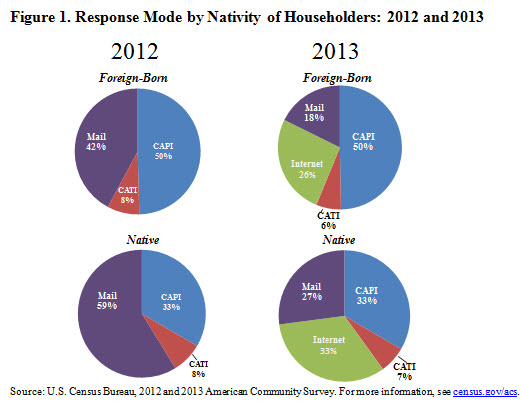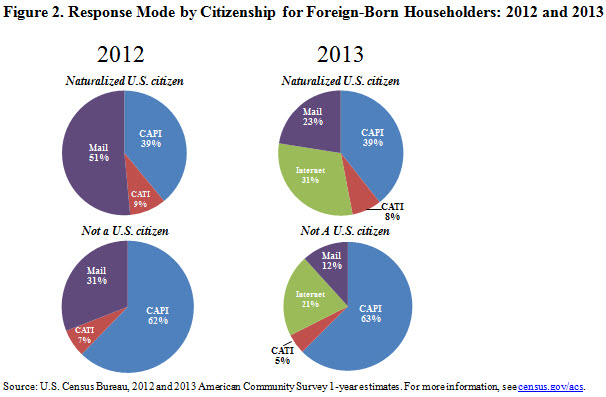Reaching the Foreign-Born: An Examination of Mode of Response by Nativity in the American Community Survey
Reaching the Foreign-Born: An Examination of Mode of Response by Nativity in the American Community Survey
The American Community Survey is collected using a variety of response modes. From 2005 to 2012, the survey was administered by mail, telephone (Computer Assisted Telephone Interview [CATI]), or in person (Computer Assisted Personal Interview [CAPI]). In 2013, the American Community Survey added an internet response option. This entry will summarize how offering the internet option affected response patterns of the foreign-born population.
American Community Survey response modes vary across the population, especially for subgroups such as the foreign-born population. A “foreign-born” person is anyone who was not a U.S. citizen at birth, including those who became U.S. citizens through naturalization. A “native” is anyone who was a U.S. citizen at birth, including those born in the United States, as well as those born in Puerto Rico, U.S. Island Areas (the U.S. Virgin Islands, Guam, American Samoa, and the Commonwealth of the Northern Mariana Islands) or born abroad to a U.S. parent(s).
Typically, native respondents to the American Community Survey have been more likely to respond by mail than telephone or in person, while foreign-born respondents have had a higher percentage of telephone and in-person response rates. Figure 1 shows that in 2012, 59 percent of natives responded by mail, 8 percent by telephone, and 33 percent by in-person interview. In contrast, 42 percent of the foreign-born responded by mail, 8 percent by telephone, and 50 percent by in-person interview. The tendency not to respond as much to initial contacts via mail is one reason why the foreign-born are sometimes referred to as a “hard-to-reach” population.
In 2013, natives were more likely than the foreign-born to respond by internet. For both the native and foreign-born population, introduction of the internet mode appears to have reduced the percentage responding by mail, while the telephone and in-person response rates appear mostly unchanged.
Looking only at foreign-born householders in Figure 2, naturalized citizens were more likely to respond by mail or internet than noncitizens. For both naturalized and noncitizens, introduction of the internet mode appears to have reduced the percentage responding by mail, while in-person responses appear mostly unchanged.
Additional research indicated that response patterns by age and sex were similar for natives and the foreign-born. Among householders below the poverty line, the foreign-born were more likely to use in-person modes and less likely to respond by mail or internet than natives. Finally, among foreign-born householders, higher English-language ability corresponded with greater internet response and lower use of in-person modes.
In conclusion, the foreign-born respond less often by mail and internet and more often by in-person interviews than the native-born. For both the native and foreign-born population, introduction of the internet mode appears to have reduced mail response, while in-person and telephone responses appear mostly unchanged. This suggests that respondents who previously responded by mail are now using the internet option. “Hard to reach” populations such as the foreign-born that respond more by telephone and through in-person interviews will likely continue to respond at high rates using those modes, even with the introduction of the internet mode of response.





